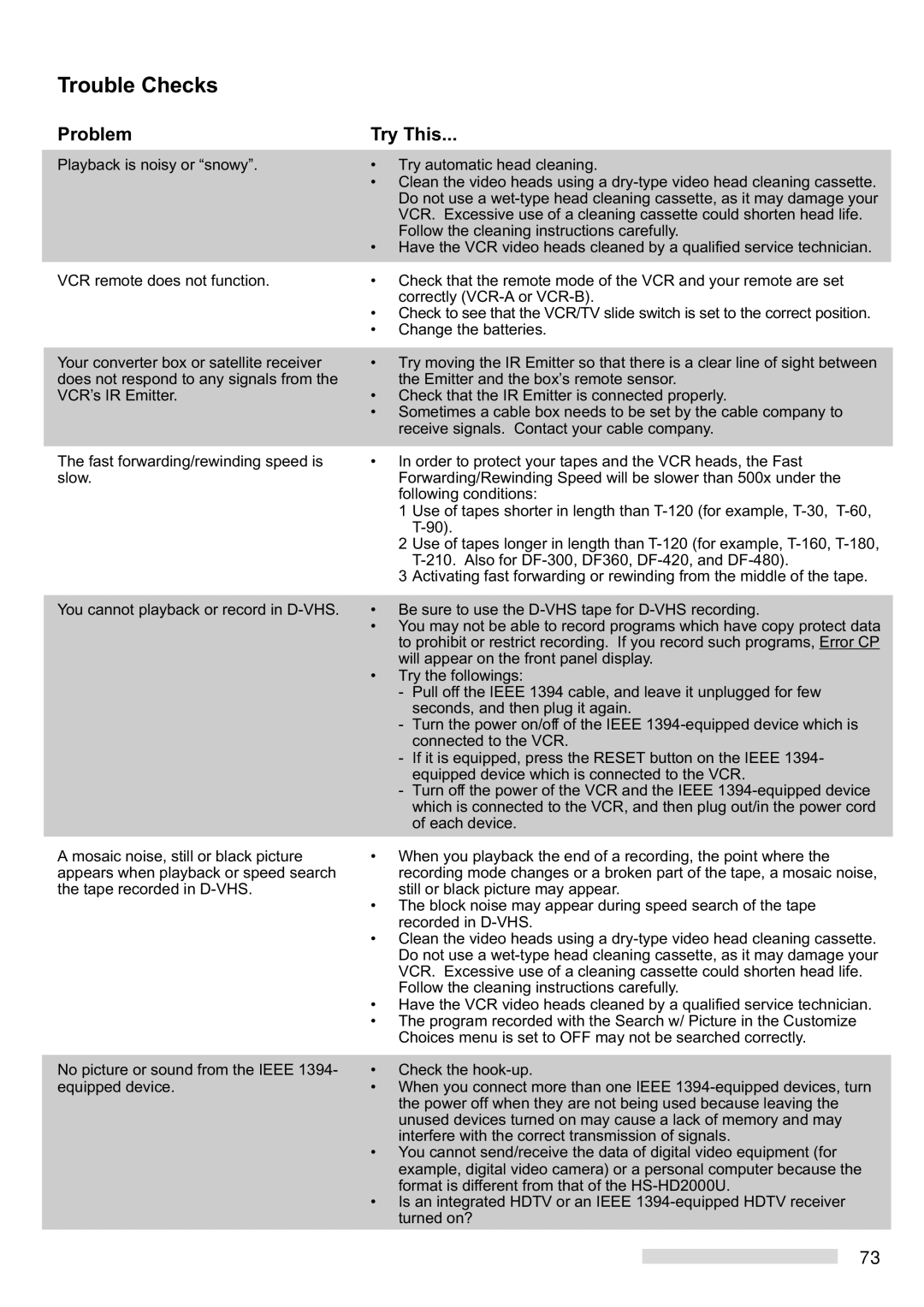
Trouble Checks
Problem | Try This... | |
|
|
|
Playback is noisy or ÒsnowyÓ. | ¥ | Try automatic head cleaning. |
| ¥ | Clean the video heads using a |
|
| Do not use a |
|
| VCR. Excessive use of a cleaning cassette could shorten head life. |
|
| Follow the cleaning instructions carefully. |
| ¥ | Have the VCR video heads cleaned by a qualified service technician. |
|
|
|
VCR remote does not function.
¥Check that the remote mode of the VCR and your remote are set correctly
¥Check to see that the VCR/TV slide switch is set to the correct position.
¥Change the batteries.
Your converter box or satellite receiver | ¥ | Try moving the IR Emitter so that there is a clear line of sight between | |
does not respond to any signals from the |
| the Emitter and the boxÕs remote sensor. | |
VCRÕs IR Emitter. | ¥ | Check that the IR Emitter is connected properly. | |
| ¥ | Sometimes a cable box needs to be set by the cable company to | |
|
| receive signals. Contact your cable company. | |
|
|
| |
The fast forwarding/rewinding speed is | ¥ | In order to protect your tapes and the VCR heads, the Fast | |
slow. |
| Forwarding/Rewinding Speed will be slower than 500x under the | |
|
| following conditions: | |
|
| 1 | Use of tapes shorter in length than |
|
|
| |
|
| 2 | Use of tapes longer in length than |
|
|
| |
|
| 3 | Activating fast forwarding or rewinding from the middle of the tape. |
You cannot playback or record in
¥You may not be able to record programs which have copy protect data to prohibit or restrict recording. If you record such programs, Error CP will appear on the front panel display.
¥Try the followings:
-Pull off the IEEE 1394 cable, and leave it unplugged for few seconds, and then plug it again.
-Turn the power on/off of the IEEE
-If it is equipped, press the RESET button on the IEEE 1394- equipped device which is connected to the VCR.
-Turn off the power of the VCR and the IEEE
A mosaic noise, still or black picture appears when playback or speed search the tape recorded in
¥When you playback the end of a recording, the point where the recording mode changes or a broken part of the tape, a mosaic noise, still or black picture may appear.
¥The block noise may appear during speed search of the tape recorded in
¥Clean the video heads using a
Follow the cleaning instructions carefully.
¥Have the VCR video heads cleaned by a qualified service technician.
¥The program recorded with the Search w/ Picture in the Customize Choices menu is set to OFF may not be searched correctly.
No picture or sound from the IEEE 1394- | ¥ | Check the |
equipped device. | ¥ | When you connect more than one IEEE |
|
| the power off when they are not being used because leaving the |
|
| unused devices turned on may cause a lack of memory and may |
|
| interfere with the correct transmission of signals. |
| ¥ | You cannot send/receive the data of digital video equipment (for |
|
| example, digital video camera) or a personal computer because the |
|
| format is different from that of the |
| ¥ | Is an integrated HDTV or an IEEE |
|
| turned on? |
|
|
|
73
